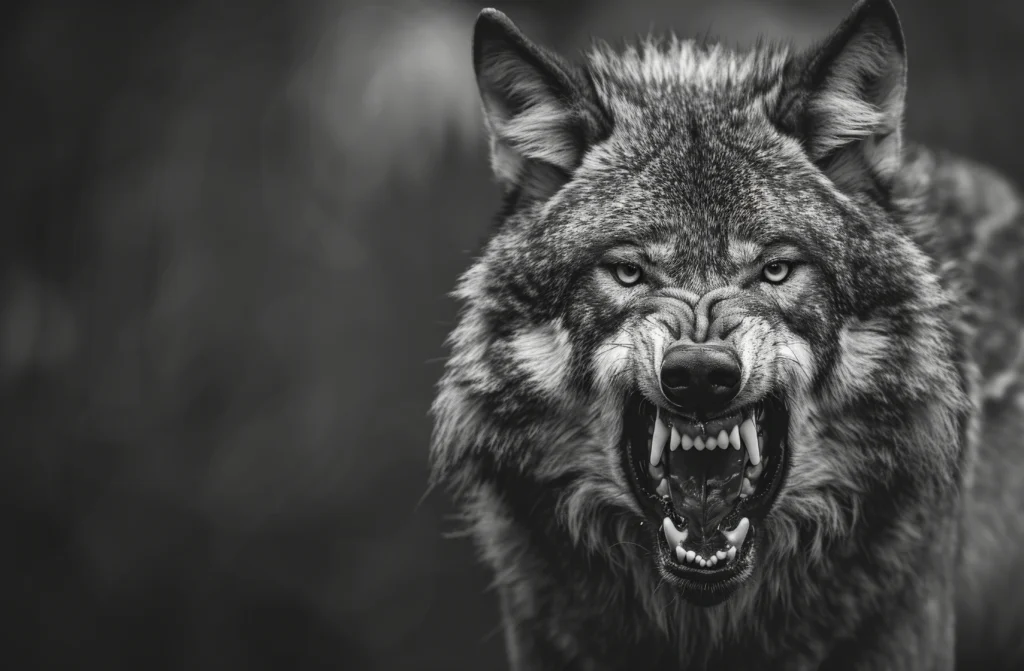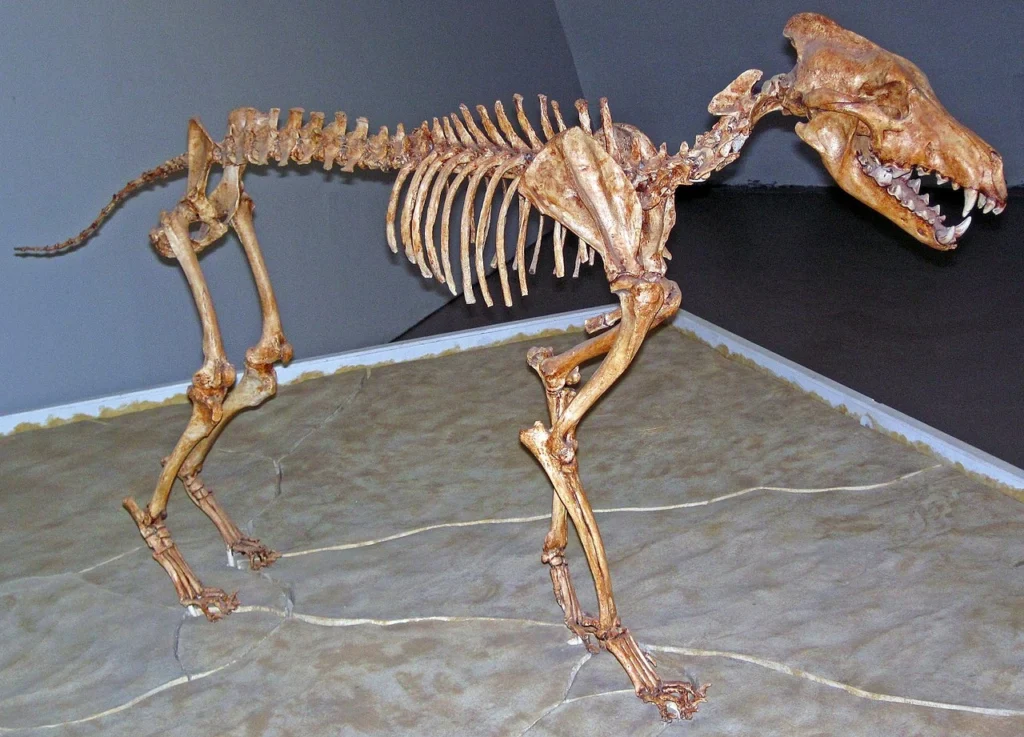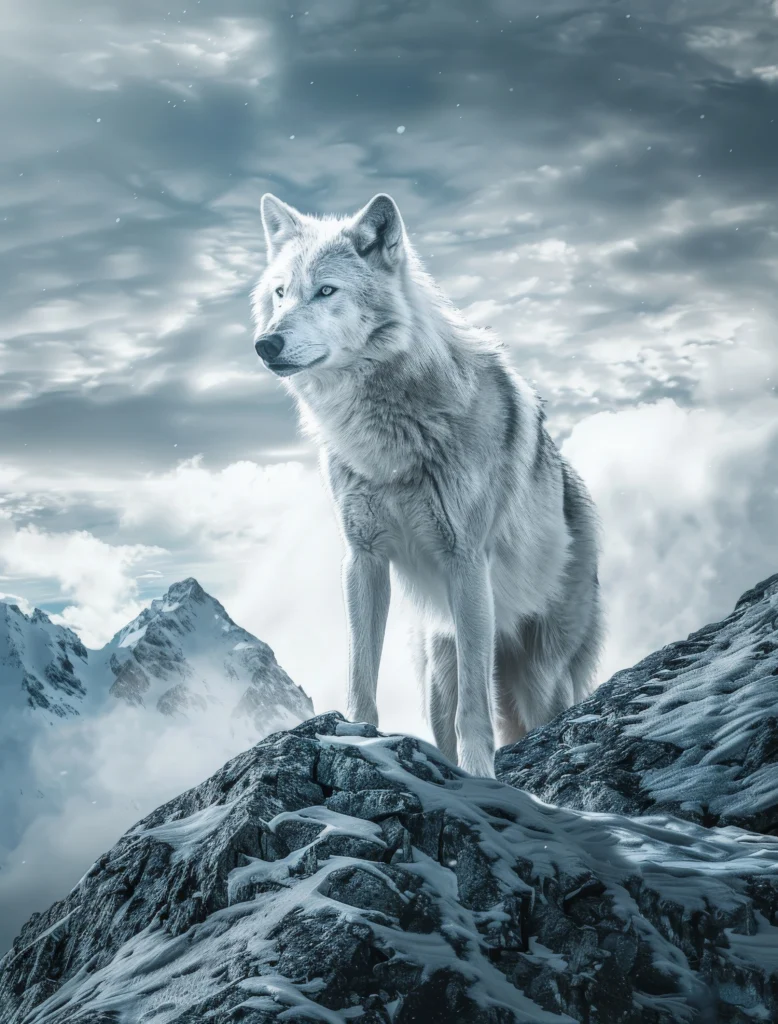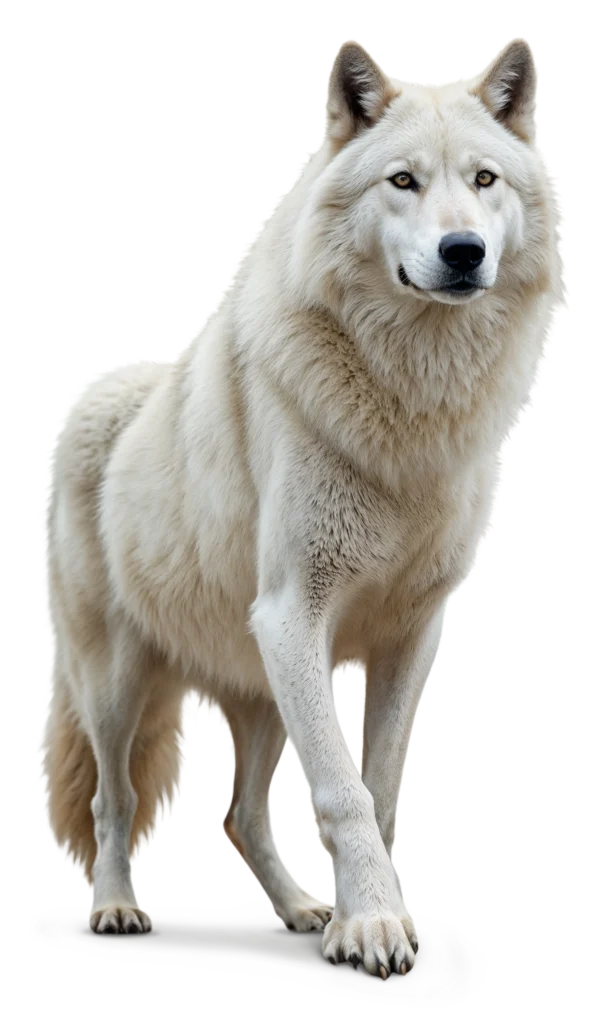There are creatures that live on in myth and memory—beasts we imagine prowling through ancient forests, their presence felt in folklore, fiction, and dreams of a wilder world. Among them stands the dire wolf, a name that conjures images of primal power, prehistoric hunts, and icy landscapes. Made famous in recent years by pop culture phenomena like Game of Thrones, the real-life dire wolf was even more fascinating than fiction could imagine: a powerful Ice Age predator that once dominated the wilds of North and South America.
For decades, scientists believed they understood the dire wolf’s place in the evolutionary tree—just a bigger, bulkier cousin of the modern gray wolf. But recent discoveries are challenging everything we thought we knew. Thanks to cutting-edge DNA research, the dire wolf’s true identity is being revealed, and the findings are nothing short of extraordinary. Not only were dire wolves genetically unique, but they also diverged from the ancestors of today’s wolves millions of years ago, forming their own mysterious branch of the canine family tree.
And now, the plot thickens. As scientists delve deeper into ancient genomes and advanced genetic technologies, whispers of something once unthinkable are starting to circulate: could the dire wolf, or at least aspects of it, one day return?
This article explores the thrilling new science behind the dire wolf’s rediscovery, what it teaches us about extinction and evolution, and the growing field of de-extinction that’s pushing the boundaries of what’s possible. Whether you’re a nature lover, a science geek, or just someone captivated by stories of wild, untamed Earth, this is a journey into the past—and maybe, just maybe, a glimpse into the future.

What Exactly Is a Dire Wolf?
The name dire wolf conjures images of ferocious, oversized canines prowling through snow-covered forests, eyes glowing, jaws ready to snap. While they’ve gained pop culture fame thanks to shows like Game of Thrones, the real dire wolf was a genuine apex predator—an awe-inspiring animal that once dominated the wild landscapes of prehistoric North and South America. But what exactly was a dire wolf, and how did it differ from the wolves we know today?
Scientifically named Aenocyon dirus, meaning “terrible wolf,” the dire wolf lived during the Late Pleistocene epoch, dating back roughly 250,000 years and vanishing about 10,000 years ago. For decades, paleontologists thought dire wolves were close cousins of the modern gray wolf (Canis lupus), based on their similar skeletal features. However, new genetic research has turned that assumption on its head. Dire wolves weren’t just a larger version of today’s wolves—they were something much more distinct and ancient, having diverged from the wolf lineage more than 5 million years ago. This revelation has placed them in their own unique genus, separate from Canis altogether.
In terms of physical appearance, dire wolves were robust, muscular, and powerful. They measured up to 1.5 meters (around 5 feet) in body length and could weigh between 130 to 150 pounds (59–68 kg), making them significantly heavier and stockier than their modern relatives. Their limbs were shorter and sturdier, adapted more for strength and endurance than speed. Their massive skulls housed powerful jaws with large, durable teeth designed to crush bone—an adaptation that served them well in scavenging as well as hunting.
These predators weren’t solitary; fossil evidence—especially the rich collection of over 4,000 dire wolf specimens found at the La Brea Tar Pits in Los Angeles—suggests that they lived and hunted in packs. Their social structure likely mirrored that of modern wolves, relying on group tactics to take down large prey such as Ice Age bison, giant ground sloths, camels, and young mammoths.
The dire wolf’s reign came to an end roughly 10,000 years ago during a period of massive environmental upheaval. As the Ice Age ended, rising temperatures transformed habitats, and the megafauna that dire wolves depended on began to disappear. With their specialized build and limited adaptability, dire wolves couldn’t pivot to new prey or environments as quickly as other canids. Meanwhile, competition from other predators—such as saber-toothed cats, humans, and even the more adaptable gray wolf—further threatened their survival.
Despite their extinction, dire wolves have left a lasting legacy. Their fossils continue to be among the most frequently discovered Ice Age specimens in North America, sparking ongoing scientific fascination. And now, with advanced DNA analysis revealing that these creatures were far more genetically unique than once believed, the dire wolf is getting a scientific renaissance—a second life not in the wild, but in the laboratories and imaginations of researchers and enthusiasts around the world.
In short, the dire wolf wasn’t just a bigger wolf. It was an entirely different kind of predator—ancient, iconic, and mysterious. And today, as scientists uncover new layers to its story, the dire wolf is once again howling its way into the spotlight.

The Shocking Discovery
For over a century, dire wolves were viewed through a lens shaped by assumption and anatomical similarity. Their fossilized remains—massive skulls, thick bones, and fearsome teeth—spoke of a powerful predator that once dominated the late Pleistocene wilderness. Because of their striking resemblance to modern gray wolves (Canis lupus), scientists long classified them as close cousins, assuming they evolved along similar lines and likely shared behaviors, prey, and even genetic overlap.
But beneath the surface of these ancient bones, a different story was waiting to be told—one that would remain hidden until the arrival of 21st-century science.
In 2021, a team of international researchers—led by scientists from UCLA, Durham University, and the University of Adelaide—published a landmark study in the journal Nature. Using highly sensitive genomic techniques, they successfully extracted and sequenced ancient DNA from five dire wolf fossils, some over 50,000 years old, found in locations across North America including Wyoming, Idaho, and Tennessee. It was the first time the dire wolf’s genome had ever been decoded, and what it revealed was nothing short of revolutionary.
The findings flipped decades of assumptions on their head.
Rather than being a close relative of the gray wolf, the dire wolf turned out to be something much more ancient and genetically distant. In fact, dire wolves diverged from the lineage that led to today’s gray wolves, coyotes, and domestic dogs over 5.7 million years ago—a staggering amount of time in evolutionary terms. That puts them not just in a different species or subspecies, but in an entirely separate genus, Aenocyon, meaning “terrible dog”—a name originally proposed in the 19th century but largely forgotten until now.
This means dire wolves weren’t wolves in the modern sense at all.
They were part of a long-lost evolutionary branch that thrived in isolation for millions of years, evolving into apex predators perfectly suited for the megafauna-rich world of the Ice Age. Unlike modern wolves, which tend to be more adaptable and widespread, dire wolves may have been more specialized, both in their physical traits and their ecological role.
Even more fascinating was the discovery that dire wolves never interbred with other canid species, despite sharing the same habitats for thousands of years. In contrast, modern wolves, coyotes, and even domestic dogs frequently interbreed and produce fertile offspring. But dire wolves remained genetically isolated, suggesting that their evolutionary divergence had reached a point where crossbreeding was no longer possible. This lack of gene flow, coupled with environmental upheaval and competition at the end of the Ice Age, may have contributed to their ultimate extinction.
The implications of this genetic revelation are enormous. It’s a reminder that appearances can be deceiving in the natural world—that two animals can look nearly identical but be worlds apart in their ancestry and biology. It also forces a reevaluation of Ice Age ecosystems: dire wolves weren’t just another flavor of wolf; they were a uniquely North American predator, shaped by and for a world that no longer exists.
Perhaps most tantalizing of all, this discovery opens new doors in the rapidly advancing field of ancient genetics and de-extinction science. If we now understand the dire wolf’s genome, could we one day reintroduce parts of its DNA into living species? Could selective breeding or gene editing help revive its traits in a modern canid form? While these ideas are still theoretical, they are no longer purely science fiction.
What began as a dusty fossil in a tar pit has now become the center of a global scientific conversation—one that blurs the boundaries between extinction, evolution, and possibility.
In many ways, the dire wolf is no longer just an ancient predator frozen in time. It has become a bridge between the past and the future, reminding us that the history of life on Earth is deeper, stranger, and more interconnected than we ever imagined.

So, What’s This About a “Return”?
It may seem like science fiction—the idea of extinct species being resurrected from the grave, their genes carefully reconstructed, their features returned to the world. The possibility of a return for the dire wolf, a creature that hasn’t walked the Earth for over 10,000 years, might sound fantastical. But recent developments in genetic science and biotechnology are pushing the boundaries of what we thought was possible, and the dream of de-extinction is no longer confined to the realm of movies like Jurassic Park.
So, what exactly is going on with the idea of the dire wolf’s return? The discovery of its unique and ancient genome, alongside the growing advancements in genetic editing and cloning techniques, has sparked a new conversation about whether we might one day see a “resurrection” of this Ice Age predator—or at least some of its characteristics in living animals. While this is still very much a speculative endeavor, the science of de-extinction is advancing at an accelerated pace, leading some to believe that we could one day see a version of the dire wolf reappear in the wild.
De-extinction is a field of science dedicated to the idea of bringing extinct species back to life, often by using cutting-edge techniques like genetic engineering, cloning, and selective breeding. While some of the more high-profile projects have focused on animals like the mammoth or the passenger pigeon, the dire wolf presents a unique challenge—and opportunity.
Here’s the basic premise: thanks to the success of modern gene sequencing and DNA extraction techniques, scientists now have the genetic blueprint of the dire wolf. Unlike the early days of paleontology, when scientists could only study the shape of bones, today’s technology allows us to look at the very building blocks of life—DNA. This is what makes the idea of resurrecting extinct species so tantalizing: the DNA exists, and with the right tools, we can decode it, understand it, and potentially bring it back into the living world.
The idea of reviving the dire wolf could be pursued in two primary ways:
- Cloning – Cloning involves taking a specimen’s preserved DNA and using it to create a genetically identical organism. In theory, if we could find perfectly preserved dire wolf DNA, we could attempt to clone a living animal using techniques similar to those used to clone animals like sheep and cattle (most famously, Dolly the sheep). However, this approach is complicated. Most preserved dire wolf DNA has been degraded over time, and even the best-preserved samples are far from perfect. It’s also unclear whether scientists could successfully create a viable embryo or embryo-hosting surrogate for a dire wolf clone.
- Gene Editing – The second and potentially more realistic method is gene editing, specifically using tools like CRISPR-Cas9. This technique allows scientists to edit specific genes within an organism’s DNA. By editing the genome of a closely related species—such as the modern gray wolf or even a domestic dog—we could introduce genes from the dire wolf that would bring about some of its physical traits and behaviors. This process is sometimes called “resurrection biology” or “de-extinction.” It’s a form of genetic remixing, where scientists attempt to bring back extinct traits, without necessarily resurrecting an exact clone of the species.
While the idea of creating a modern version of the dire wolf through gene editing may sound incredible, it’s not without its challenges and ethical concerns. Should we bring back an extinct species at all? After all, there are many risks associated with reintroducing creatures into environments that have changed drastically since their extinction. Would a revived dire wolf even survive in today’s world? Could it be an ecological hazard? Moreover, there are also questions about animal welfare and the potential suffering of an engineered species created through genetic manipulation.
The concept of bringing back the dire wolf also leads us into the murky waters of ethics. Many scientists and conservationists argue that we should focus on preserving and protecting species that are still with us, rather than resurrecting the past. Others see it as an opportunity to right the wrongs of extinction—especially since many species, like the dire wolf, were driven to extinction due to human activities. By understanding the genetic makeup of extinct species, we could not only bring them back but also help safeguard the biodiversity of the future.
Moreover, the possibility of reintroducing a species like the dire wolf could be part of a larger plan to restore the Pleistocene rewilding initiative. This controversial conservation effort aims to reintroduce large herbivores and predators to restore ecological balance. Some proponents even suggest that large predators like the dire wolf could help control modern populations of herbivores, potentially preventing overgrazing and assisting in the restoration of plant life in certain ecosystems. However, such projects are still highly speculative and come with significant risks—both to the ecosystem and to the species being revived.
It’s important to note that, while scientists are excited by the potential of de-extinction, this is still a concept very much in the realm of hypothetical and early-stage science. The complexities of DNA preservation, genetic manipulation, and ecological impacts mean that reviving the dire wolf is a project that could take decades—or longer—before it becomes a reality.
However, the return of the dire wolf, whether through a living clone or an engineered version of the species, could one day become a symbol of how science is changing our relationship with the past. It forces us to question what it means to “bring something back”—and whether the future of conservation and biodiversity should include efforts to resurrect the extinct, or focus on saving what we still have.

Why It Matters
The story of the dire wolf is more than just the tale of an ancient predator lost to time. It’s a symbol of the intersection between science, ethics, and our evolving relationship with nature. As we continue to push the boundaries of what’s possible with genetic research and biotechnology, the question of whether we can—and should—bring back extinct species like the dire wolf goes far beyond mere curiosity. It challenges us to think about our role in the natural world, the value of biodiversity, and the responsibilities we carry as stewards of the planet.
A Window into Earth’s Past
First and foremost, the rediscovery of the dire wolf’s genetic makeup provides us with an invaluable window into Earth’s distant past. The fossilized remains of this Ice Age predator have already given us some clues about how it lived and hunted. But now, thanks to genetic research, we’re able to go deeper, beyond bones and teeth, and examine the very DNA that formed the creature. By sequencing ancient genomes, we are learning more about the species’ evolution, diet, behavior, and interaction with its environment—painting a more detailed picture of the ancient ecosystems that shaped modern wildlife.
Understanding the dire wolf’s evolutionary history can help us trace the paths of extinction and survival across millions of years. This research gives scientists a clearer sense of how animals adapt to changing climates, ecosystems, and human influences. The more we understand these ancient species, the better equipped we are to face the challenges of climate change, habitat loss, and other factors currently threatening species on the brink of extinction.
The Rise of De-Extinction Science
Perhaps the most transformative aspect of the dire wolf’s rediscovery is how it highlights the growing field of de-extinction. This science, which focuses on bringing back extinct species through genetic techniques, was once the stuff of science fiction. But with advancements in gene editing, DNA sequencing, and cloning technologies, the concept of resurrecting species like the mammoth, the passenger pigeon, or even the dire wolf is beginning to shift from a far-off dream to a more tangible goal.
The idea of reviving extinct animals raises important scientific questions that extend beyond just biology. It pushes the limits of what we know about genetics, biodiversity, and the role humans have played in the extinction of species. In the case of the dire wolf, its potential return isn’t simply about recreating a long-gone animal—it’s about exploring the possibilities of genetic restoration and understanding how we can use genetic science to better manage ecosystems today.
While we’re still a long way from bringing back the dire wolf, the research paves the way for innovative conservation techniques. By studying the DNA of extinct species, scientists could better understand the traits that made them successful, as well as the vulnerabilities that led to their extinction. This knowledge could be used to help protect endangered species by strengthening their genetic diversity or developing new strategies for habitat preservation.
Ethical and Ecological Questions
But it’s not just about the science—it’s about the ethics of de-extinction. If we can bring back species like the dire wolf, should we? The ethical questions surrounding de-extinction are profound. Would it be responsible to reintroduce a species into an ecosystem that has changed drastically since its extinction? For example, if a revived dire wolf were introduced into the wild, what impact would it have on the modern environment, including existing species? Could it disrupt the delicate balance of ecosystems that have evolved in the absence of such predators?
There are also questions about animal welfare. The process of creating a de-extinct species, whether through cloning or genetic engineering, is not without significant challenges. These creatures would be produced in a lab and raised in a human-controlled environment, potentially leading to physical and psychological issues. There’s a moral dilemma about creating a living being without knowing whether it would thrive or suffer in a modern world so different from the one it evolved in.
Furthermore, there’s the issue of ecological balance. Rewilding—the practice of reintroducing extinct or endangered species to their natural habitats—is becoming more popular in conservation circles, but it’s a highly controversial approach. Would the return of a predator like the dire wolf help to restore balance, or would it disrupt food chains in ways we cannot predict? Could it become a new invasive species, placing strain on ecosystems already suffering from the loss of biodiversity?
A New Frontier in Conservation
Finally, the resurgence of interest in the dire wolf and other extinct species points to a larger shift in conservation strategies. As the global biodiversity crisis deepens—driven by deforestation, climate change, pollution, and poaching—scientists and conservationists are increasingly looking for bold solutions to protect the planet’s wildlife. While traditional conservation methods such as habitat preservation and anti-poaching efforts remain crucial, they may not be enough to reverse the damage done by centuries of human activity.
The concept of de-extinction presents a new frontier in conservation—one that blends cutting-edge genetics with the urgent need to restore ecosystems and protect the species that remain. Imagine using genetic research not only to bring back extinct species like the dire wolf, but also to strengthen populations of animals teetering on the brink of extinction today. By leveraging the tools of modern science, we could help create a more robust and diverse natural world—one that can withstand the challenges of the future.
In the end, the return of the dire wolf, whether as a full-fledged reintroduction or as a part of a broader genetic initiative, offers us a powerful reminder: the past isn’t truly gone. It’s hidden within the DNA of ancient animals, waiting to be unlocked by the scientific tools of tomorrow. The fate of these creatures, and perhaps even the fate of our planet’s biodiversity, depends on the choices we make now—and the values we place on preserving the world that exists, and the world that once was.
Final Thoughts
The return of the dire wolf—whether through groundbreaking genetic research, de-extinction science, or simply as a symbol of lost ecosystems—has captured the imagination of people around the world. It’s a reminder that the past is never fully gone; it is embedded in our natural world, waiting to be rediscovered and understood. While the dire wolf may never truly walk the Earth again, its story is one of mystery, wonder, and possibility.
What began as a curious fossil, buried deep within the Earth’s layers, has now evolved into a significant scientific exploration. The dire wolf was more than just a predator of the Ice Age; it was a living testament to the intricate web of life that once thrived across the planet. Its genetic resurrection, even in theory, pushes us to reconsider not only the creatures of the past but also how we engage with the biodiversity crisis unfolding before us today.
As science advances, and we inch closer to unlocking the potential of de-extinction, we must ask ourselves: What are we trying to achieve with these endeavors? Is it about correcting past wrongs or opening up new possibilities for the future? The revival of an extinct species like the dire wolf could offer critical insights into genetics, evolutionary biology, and conservation efforts, but it also poses deep ethical and ecological questions that require careful consideration.
In this new era of technology and innovation, we must not only think about what’s possible but also what’s responsible. Could resurrecting an extinct species help us restore lost ecosystems, or should our efforts be focused on protecting the species that still roam the Earth today? The questions are complex, and the answers will not come easily.
But one thing is clear: the dire wolf’s story is far from over. Its return to the spotlight—whether in the form of ancient fossils or as part of cutting-edge genetic projects—has sparked a deeper conversation about life, extinction, and the future of the natural world. The answers lie not just in the labs of today, but in the values we place on the preservation of the planet for future generations.
The dire wolf may never return in full form, but its legacy challenges us to look forward, learn from the past, and consider how science can be used to heal the wounds we have inflicted on nature. In doing so, we might just find a way to build a more harmonious future for both the creatures of the past and the ones still with us.